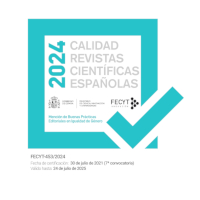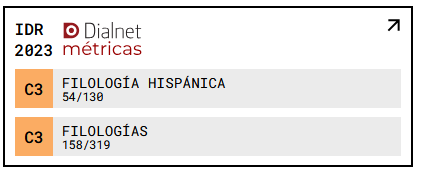Anthropological function of the chronotope in the plot of the “Russian Robinsons”
DOI:
https://doi.org/10.18172/cif.5817Keywords:
Chronotope, Anthropological function of the chronotope, Behavioral models, Russian Robinsons, Le Royl, Zinoviy DavydovAbstract
The anthropological approach to a work of art is a current trend in literary criticism. Man is the subject and object of artistic anthropology. Using the traditional literary concept of chronotope, this article attempts to explain the place of a person in the picture of the world of a work of art. The work pays special attention to the category of chronotope, in particular to its anthropological function. The anthropological function of the chronotope is analysed in the novel “Beruny” (1933) by Zinoviy Samoylovich Davydov. When creating his original work, the author was inspired by the story about the six-year wintering of Russian sailors on Edge Island in the 40s of the XVIII century, which was beloved by the Russian reader. The main research methods are: chronotopic text analysis, proposed by V.V. Savelyeva, A.F. Kofman, N.K. Shutaya, E.A. Komarova, A.B. Temirbolat, et al. and cultural-historical analysis. Z. Davydov's narration forms the national features of the collective image of the “Russian Robinsons”. The specificity is conveyed in the author's descriptions of the heroes' perception of space and time. The literary achievements of Z. Davydov are analyzed through the prism of two particularly important elements of any literary text - the chronotope and the image of the hero. The chronotope determines the personal qualities and thoughts, behavior and deeds of the “Russian Robinsons”. The purpose of the study is to establish the relationship between a certain chronotope and the characters' cognitive reaction to the author's indications of the coordinates of space and time, to trace the textual manifestations of the characters' inner experiences. The constructs of time and space in the novel by Z. Davydov are analyzed, and a typology of characters in his story about the disasters of the “Russian Robinsons” is built. As a result, a typology of behavioral models of “Russian Robinsons” in liminal conditions was compiled.
Downloads
References
Bakhtin, M. M. (1975). Questions of literature and aesthetics. Researches of different years. Moscow, Russia: Fiction Literature.
Bashkeeva, V. V. (2017). Literary anthropology as a method of analysis of a literary text. Russian language and literature in a multicultural space, 18–23.
Cunningham, V. (1996). If the Cap Fits: Figuring the Space of the Human. The Anthropological Turn in Literary Studies. Yearbook of Research in English and American Literature (REAL), Volume 12. Tübingen: Gunter Narr, 45–65
Davydov, Z. S. (1971). Beruny. A guest from Gosha. Moscow, Russia: Children's Literature.
Esalnek, A. Ya. (2011). The anthropological principle in the study of the novel. Artistic anthropology. Theoretical and historical-literary aspects. Materials of the International Scientific Conference “Pospelov Readings – 2009”, 35-40.
Ginzburg, L. (1979). About a literary hero. Moscow, Russia: Soviet writer.
Grabes, H. (1996). The Aesthetic Dimension: Bliss and/or Scandal. The Anthropological Turn in Literary Studies. Yearbook of Research in English and American Literature (REAL), Volume 12. Tübingen: Gunter Narr, 17–31
Jürgen Schlaeger (ed.). (1996) The Anthropological Turn in Literary Studies. Yearbook of Research in English and American Literature (REAL), Volume 12. Tübingen: Gunter Narr, 299 p.
Kofman, A. F. (2013). Fiction Space and Time in Chekhov’s Plays “The Seagull”, “Three Sisters” and “The Cherry Orchard”. Culture and art, 5, 516-524.
Komarova, E. A. (2010). Joris-Karl Huysmans: Through space and time. Ivanovo, Russia: Ivanovo State University.
Kondratiev, A. S. (2022). Artistic Anthropology of “War and Peace” by L.N. Tolstoy in the context of the Spiritual tradition of Russian culture. L.N. Tolstoy in the human consciousness of the digital age. Materials of the XXXVIII International Tolstoy Readings dedicated to the 194th anniversary of the writer's birth. (ed.) D.A. Romanov. Tula, 20-23.
Kozlov, S. V. (2016). Literary anthropology and poetics of the character. Severodvinsk, Russia: Northern (Arctic) Federal University named after M. V. Lomonosov.
Lecercle, J.-J. (1996) The “Turn” in Literary Studies: Antropology, or Pragmatics, or Both. The Anthropological Turn in Literary Studies. Yearbook of Research in English and American Literature (REAL), Volume 12. Tübingen: Gunter Narr, 1-17.
Matyushkina, E. N. (2022). Historical novels by B. Okudzhava: some aspects of artistic anthropology. Izvestia of the Smolensk State University, 4 (60), 25–35. http://doi.org/10.35785/2072-9464-2022-60-4-25-35 DOI: https://doi.org/10.35785/2072-9464-2022-60-4-25-35
Muller, K. P. (1996). The Enactment or Bringing Forth of Meaning from a Background of Understanding” – Constructivism, Anthropology, and (Non-)Fictional Literature. The Anthropological Turn in Literary Studies. Yearbook of Research in English and American Literature (REAL), Volume 12. Tübingen: Gunter Narr, 65-81.
Muminov, S. O. (2018). The originality of the art of anthropology in the novel of A. Bely “Petersburg”. Bulletin of the WKSU, 3(71), 224-231.
Nichiporov, I. B. (2021). “Zinc Boys” and “Chernobyl Man” in Svetlana Alexievich᾿s Documentary-Artistic Anthropology. Stephanos, 4 (48), 23-28. http://doi.org/10.24249/2309-9917-2021-48-4-23-28 DOI: https://doi.org/10.24249/2309-9917-2021-48-4-23-28
Orlova, E. A. (2010). History of anthropological doctrines. Moscow, Russia: Academic project.
Saveleva, V. V. (2002). Artistic text and the artistic world: correlation and organization. Author’s abstract of Doct. Diss. Almaty, 48.
Savelyeva, V. V. and Abdullina L. I. (Ed.). (2007). Art anthropology and the work of the writer. Ust-Kamenogorsk; Almaty, Russia: Restit LLP.
Shutaya, N. K. (2007). Typology of artistic time and space in the Russian novel of the XVIII–XIX centuries. Author’s abstract of thesis. Moscow, 35 p.
Shvetsova, T. V. and Shakhova, V. E. (2022). The chronotope problem in the historical novel by Z. Davydova “Russian Robinsons” (“Beruny”). In T. A. Sharypina, M. K. Menschikova (ed.), Languages of History and languages of literature (pp. 375-382). Nizhny Novgorod, Russia: National Research Nizhny Novgorod State University named after N. I. Lobachevsky.
Skotnikova, N. S. (2010). The anthropological paradigm of Russian culture of the second half of the XIX century: philosophy and art. Thesis. Saransk, 149 s.
Smirnov, S. A. (2012). New identities of man: analysis and forecast of anthropological trends anthropological foresight. Man.ru. 8, 249-269.
Temirbolat, A. B. (2009). Categories of chronotope and temporal rhythm in literature. Almaty, Russia: Securities.
Toporov, V. N. (1984). Petersburg and the Petersburg text of Russian literature. In Y. M. Lotman (ed.), Semiotics of the city and urban culture. Works on sign systems XVIII (pp. 4-29). Tartu, Estonia: Tartu State University.
Turysheva, O. N. (2019). Lars von Trier: from artistic anthropology to artistic aesthetics. Vremnik of the Zubov Institute, 4 (27), 84-94.
Downloads
Published
How to Cite
Issue
Section
License
Copyright (c) 2023 Tatyana Shvetsova, Veronika Shakhova , Svetlana Dulova

This work is licensed under a Creative Commons Attribution 4.0 International License.
The authors retain copyright of articles and authorize CIF the first publication. They are free to share and redistribute the article without obtaining permission from the publisher as long as they give appropriate credit to the editor and the journal.
Self-archiving is allowed too. In fact, it is recommendable to deposit a PDF version of the paper in academic and/or institutional repositories.
It is recommended to include the DOI number.
This journal is licensed under a Creative Commons Attribution 4.0 International License














